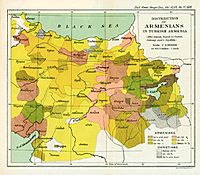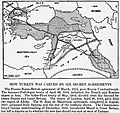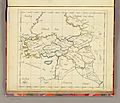Western Armenia facts for kids
Western Armenia (Armenian: Արևմտյան Հայաստան), also referred to as Byzantine Armenia, later Turkish Armenia, or Ottoman Armenia is a term coined following the division of Greater Armenia between Byzantine Empire (Western Armenia) and Persia (Eastern Armenia) in 387 AC.
History
After the death of Armenian king Arshak III, in 390 AC, the Western Armenia was governed by Greek generals. In the 7th century Western Armenia was one of the centers of Pavlikian Christian popular sect. Since 9th century the most part of Western Armenia included Vaspurakan and Taron was under the rule of Bagratid dynasty of Armenia. Then the Zakarid Armenia of 13-14th centuries included some parts of Western Armenia.
After Turkish-Persian wars of 1602-1639 Western Armenia became part of Ottoman Empire. Since Russo-Turkish War, 1828-1829 that term is referred to the Armenian-populated historical regions of the Ottoman Empire that remained under Ottoman rule after the eastern part was ceded to the Russian Empire.
Western (Ottoman) Armenia was composed of six vilayets (vilâyat-ı sitte), the vilayets of Erzurum, Van, Bitlis, Diyarbekir, Kharput, and Sivas. After the collapse of Ottoman Empire Western Armenia remained under Turkish rule, and in 1894–96 and 1915 Turkey perpetrated systematic massacres and forced deportations of Armenians.
After the Armenian genocide the distinct Western Armenian dialect of the Armenian language (recognized as one of the major dialects of Armenian [1]) is spoken primarily in Istanbul, Lebanon, Egypt, other parts of Armenian diaspora, and formerly in eastern Turkey. It differs orthographically from Eastern Armenian, there are also phonological differences. In some parts of the diaspora, the Armenian schools, such as L'École Arménienne Sourp Hagop and the Armenian Sisters Academy instruct Western Armenian to the students, instead of Eastern Armenian, the official dialect of the Republic of Armenia.
Modern period
The fate of Western Armenia — commonly referred to as "The Armenian Question" — is considered as a key issue in the modern history of the Armenian people. The first and second congresses of Western Armenians took place in Yerevan in 1917 and 1919. Since 2000, an organizing committee of congress of heirs of Western Armenians who survived the Armenian Genocide is active in diasporan communities.
Related pages
Images for kids
-
The treaties as summarized in 1923 by Ray Stannard Baker, who was Woodrow Wilson's press secretary during the Paris Peace Conference.
-
A 1927 version of the map used by the Grand National Assembly of Turkey (later restored)
-
The Six Armenian vilayets (provinces) of the Ottoman Empire were defined as Western Armenia.
-
The modern concept of United Armenia as used by Woodrow Wilson and the Armenian Revolutionary Federation (Dashnaktsutyun).
See also
 In Spanish: Armenia Occidental para niños
In Spanish: Armenia Occidental para niños













